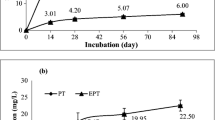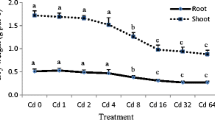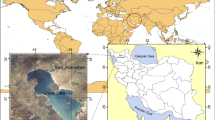Abstract
Glasshouse experiments were conducted to determine the accumulation, distribution and transformation of o,p′-DDT, p,p′-DDT and PCBs by common reed (Phragmites australis) and rice (Oryza sativa L.) under hydroponic conditions. The culture solution was spiked with the organic pollutants and samples were collected daily. Analysis of the plants at harvest showed that both species had removed DDT and PCBs from the solution. DDT appeared to have accumulated within P. australis by both passive adsorption and active absorption. Both o,p′-DDT and p,p′-DDT were transformed within P. australis. DDD was the major metabolite and the transformation was mediated by reductive dehalogenation. Plant long-distance transportation systems may be involved in the translocation of PCBs within P. australis and the affinity of the PCBs for lipids is one of the major factors affecting their uptake and translocation within the plants. Similar but less pronounced results were found in O. sativa and suggest that these wetland plants may be used for the plant-mediated remediation of persistent organic pollutants.
Similar content being viewed by others
References
Briggs GG, Bromilow RH, Evans AA, 1982 Relationships between lipophilicity and root uptake and translocation of non-ionized chemicals by barley Pestic Sci 13: 495–504
Campanella BF, Bock C, Schroder P, 2002 Phytoremediation to increase the degradation of PCBs and PCDD/Fs: Potential and limitations Environ Sci Pollut Res 9: 73–85
Cunningham SD, Berti WR, 1993 Remediation of contaminated soils with green plants: An overview In Vitro Cell Dev Biol 29P: 207–212
Gao J, Garrison AW, Hoehamer C, Mazur CS, Wolfe NL, 2000 Uptake and phytotransformation of o,p′-DDT and p,p′-DDT by axenically cultivated aquatic plants J Agric Food Chem 48: 6121–6127
Meagher RB, 2000 Phytoremediation of toxic elemental and organic pollutants Curr Opin Plant Biol 3: 153–162
Moza P, Weisgerber I, Klein W, Korte F, 1974 Metabolism of 2,2′-dichlorobiphenyl-14C in two plant–water–soil systems Bull Environ Contam Toxicol 12: 541–546
Pal D, Weber JB, Overcash MR, 1980 Fate of polychlorinated biphenyls (PCBs) in soil-plant systems Residue Rev 74: 45–98
Ritter L, Solomon KR, Forget J. 1995 Persistent organic pollutants: An assessment report on DDT, aldrin, dieldrin, endrin, chlordane, heptachlor, hexachlorobenzene, mirex, toxaphene, polychlorinated biphenyls, dioxins, and furans. International Programme on Chemical Safety (IPCS)
Ryan JA, Bell RM, Davidson JM, O’Connor GA, 1988 Plant uptake of non-ionic organic chemicals from soils Chemosphere 17: 2299–2323
Salt DE, Smith RD, Raskin I, 1998 Phytoremediation Ann Rev Plant Physiol Plant Mol Biol 49: 643–668
Smith AG, 1991 Chlorinated Hydrocarbon Insecticides Hayes WJ, Laws ER Eds. Handbook of Pesticides Toxicology Academic Press Inc. San Diego/ New York 731–915
Vladimir T, Valery R, Lorenzo T, 2002 Dichlorodiphenyltrichloroethane (DDT): Ubiquity, persistence, and risks Environmental Health Perspectives 110: 125–128
WHO (World Health Organization). 1989 DDT and its derivatives - Environmental Aspects. Environmental Health Criteria 83. WHO European Centre for Environment and Health International Programme on Chemical Safety, Geneva, Switzerland
Acknowledgement
This research was supported by the Central Allocation Group Research, University Grants Committee, Hong Kong (Code No: HKBU−2/00C).
Author information
Authors and Affiliations
Corresponding author
Rights and permissions
About this article
Cite this article
Chu, W., Wong, M. & Zhang, J. Accumulation, distribution and transformation of DDT and PCBs by Phragmites australis and Oryza sativa L.: I. Whole plant study. Environ Geochem Health 28, 159–168 (2006). https://doi.org/10.1007/s10653-005-9027-8
Published:
Issue Date:
DOI: https://doi.org/10.1007/s10653-005-9027-8




